Assessing the Impact of Forest Machinery Passage on Soil CO2 Concentration
Abstract
1. Introduction
2. Materials and Methods
2.1. Site Description
2.2. Experimental Design
2.3. Soil Physical and Chemical Properties
2.3.1. Measurement of Soil Penetration Resistance
2.3.2. Carbon Dioxide (CO2) Concentration, Temperature, and Moisture of Soil
2.4. Statistical Analysis
3. Results
3.1. Homogeneity of Soil Condition Within Sub-Plots
3.2. Penetration Resistance
3.3. Concentration of CO2 in the Soil
4. Discussion
4.1. Soil Compaction
4.2. Soil CO2 Concentrations
4.3. Seasonal Trend in CO2 Concentrations
4.4. Temperature and Soil Moisture Regimes
4.5. Recovery of Soil
5. Conclusions
Author Contributions
Funding
Data Availability Statement
Acknowledgments
Conflicts of Interest
References
- Huang, F.; Cao, J.; Zhu, T.; Fan, M.; Ren, M. CO2 Transfer Characteristics of Calcareous Humid Subtropical Forest Soils and Associated Contributions to Carbon Source and Sink in Guilin, Southwest China. Forests 2020, 11, 219. [Google Scholar] [CrossRef]
- Munjonji, L.; Ayisi, K.K.; Mafeo, T.P.; Maphanga, T.; Mabitsela, K.E. Seasonal Variation in Soil CO2 Emission and Leaf Gas Exchange of Well-managed Commercial Citrus sinensis (L.) Orchards. Plant Soil 2021, 465, 65–81. [Google Scholar] [CrossRef]
- Conlin, T.S.S.; Driessche, R. van den Response of Soil CO2 and O2 Concentrations to Forest Soil Compaction at the Long-Term Soil Productivity Sites in Central British Columbia. Can. J. Soil. Sci. 2000, 80, 625–632. [Google Scholar] [CrossRef]
- Feng, L.; Hu, J.; Jiang, J. Uncertainty in Soil Gas Permeability Measurements. Front. Environ. Sci. 2025, 13, 1474764. [Google Scholar] [CrossRef]
- Poungparn, S.; Komiyama, A.; Tanaka, A.; Sangtiean, T.; Maknual, C.; Kato, S.; Tanapermpool, P.; Patanaponpaiboon, P. Carbon Dioxide Emission Through Soil Respiration in a Secondary Mangrove Forest of Eastern Thailand. J. Trop. Ecol. 2009, 25, 393–400. [Google Scholar] [CrossRef]
- Allman, M.; Allmanová, Z.; Jankovský, M.; Ferenčík, M.; Messingerová, V. Damage of the Remaining Stands Caused by Various Types of Logging Technology. Acta Univ. Agric. Silvic. Mendel. Brun. 2016, 64, 379–385. [Google Scholar] [CrossRef]
- Allman, M.; Jankovský, M.; Messingerová, V.; Allmanová, Z.; Ferenčík, M. Soil Compaction of Various Central European Forest Soils Caused by Traffic of Forestry Machines with Various Chassis. For. Syst. 2015, 24, e038. [Google Scholar] [CrossRef]
- Agherkakli, B.; Najafi, A.; Sadeghi, S.H. Ground Based Operation Effects on Soil Disturbance by Steel Tracked Skidder in a Steep Slope of Forest. J. For. Sci. 2010, 56, 278–284. [Google Scholar] [CrossRef]
- Ring, E.; Andersson, M.; Hansson, L.; Jansson, G.; Högbom, L. Logging Mats and Logging Residue as Ground Protection during Forwarder Traffic along Till Hillslopes. Croat. J. For. Eng. 2021, 42, 445–462. [Google Scholar] [CrossRef]
- Warlo, H.; Von Wilpert, K.; Lang, F.; Schack-Kirchner, H. Black Alder (Alnus glutinosa (L.) Gaertn.) on Compacted Skid Trails: A Trade-off between Greenhouse Gas Fluxes and Soil Structure Recovery? Forests 2019, 10, 726. [Google Scholar] [CrossRef]
- Eliasson, L. Effects of Forwarder Tyre Pressure on Rut Formation and Soil Compaction. Silva Fenn. 2005, 39, 366. [Google Scholar] [CrossRef]
- Davidson, E.A.; Savage, K.E.; Trumbore, S.E.; Borken, W. Vertical Partitioning of CO2 Production within a Temperate Forest Soil. Glob. Change Biol. 2006, 12, 944–956. [Google Scholar] [CrossRef]
- Yamulki, S.; Forster, J.; Xenakis, G.; Ash, A.; Brunt, J.; Perks, M.; Morison, J.I.L. Effects of Clear-Fell Harvesting on Soil CO2, CH4, and N2O Fluxes in an Upland Sitka Spruce Stand in England. Biogeosciences 2021, 18, 4227–4241. [Google Scholar] [CrossRef]
- Kim, I.; Han, S.-K.; Acuna, M.; Woo, H.; Oh, J.-H.; Choi, B. Effect of Heavy Machine Traffic on Soil CO2 Concentration and Efflux in a Pinus Koraiensis Thinning Stand. Forests 2021, 12, 1497. [Google Scholar] [CrossRef]
- Mace, A.C. Recovery of forest soils from compaction by rubber-tired skidders. Minn. For. Res. Notes 1971, 4, 226. [Google Scholar]
- Jakobsen, B.F.; Greacen, E.L. Compaction of Sandy Forest Soils by Forwarder Operations. Soil Tillage Res. 1985, 5, 55–70. [Google Scholar] [CrossRef]
- Cambi, M.; Grigolato, S.; Neri, F.; Picchio, R.; Marchi, E. Effects of Forwarder Operation on Soil Physical Characteristics: A Case Study in the Italian Alps. Croat. J. For. Eng. 2016, 37, 233–239. [Google Scholar]
- Ampoorter, E.; de Schrijver, A.; van Nevel, L.; Hermy, M.; Verheyen, K. Impact of Mechanized Harvesting on Compaction of Sandy and Clayey Forest Soils: Results of a Meta-Analysis. Ann. For. Sci. 2012, 69, 533–542. [Google Scholar] [CrossRef]
- Slovenský Hydrometeorologický Ústav. Klimatický Atlas Slovenska; Slovenský Hydrometeorologický Ústav: Bratislava, Slovakia, 2015; 132p, ISBN 97880-88907-90-9. [Google Scholar]
- National Forest Centre. Forestry Information System 2023–2032; National Forest Centre: Zvolen, Slovakia, 2023.
- QGIS Development Team. QGIS Geographic Information System, Version 3.14; Open Source Geospatial Foundation: Beaverton, OR, USA, 2020. [Google Scholar]
- RStudio Team. R: A Language and Environment for Statistical Computing; R Foundation for Statistical Computing: Vienna, Austria, 2024; Available online: https://www.r-project.org/ (accessed on 10 October 2024).
- Nazari, M.; Eteghadipour, M.; Zarebanadkouki, M.; Ghorbani, M.; Dippold, M.A.; Bilyera, N.; Zamanian, K. Impacts of Logging-Associated Compaction on Forest Soils: A Meta-Analysis. Front. For. Glob. Change 2021, 4, 780074. [Google Scholar] [CrossRef]
- Benevenute, P.A.N.; de Morais, E.G.; Souza, A.A.; Vasques, I.C.F.; Cardoso, D.P.; Sales, F.R.; Severiano, E.C.; Homem, B.G.C.; Casagrande, D.R.; Silva, B.M. Penetration Resistance: An Effective Indicator for Monitoring Soil Compaction in Pastures. Ecol. Indic. 2020, 117, 106647. [Google Scholar] [CrossRef]
- Kormanek, M.; Dvořák, J.; Tylek, P.; Jankovský, M.; Nuhlíček, O.; Mateusiak, Ł. Impact of MHT9002HV Tracked Harvester on Forest Soil after Logging in Steeply Sloping Terrain. Forests 2023, 14, 977. [Google Scholar] [CrossRef]
- Ilintsev, A.; Nakvasina, E.; Högbom, L. Methods of Protection Forest Soils during Logging Operations (Review). Lesn. Zhurnal 2021, 2021, 92–116. [Google Scholar] [CrossRef]
- Högberg, P.; Nordgren, A.; Buchmann, N.; Taylor, A.F.S.; Ekblad, A.; Högberg, M.N.; Nyberg, G.; Ottosson-Löfvenius, M.; Read, D.J. Large-Scale Forest Girdling Shows That Current Photosynthesis Drives Soil Respiration. Nature 2001, 411, 789–792. [Google Scholar] [CrossRef] [PubMed]
- Subke, J.-A.; Bahn, M. On the “Temperature Sensitivity” of Soil Respiration: Can We Use the Immeasurable to Predict the Unknown? Soil Biol. Biochem. 2010, 42, 1653–1656. [Google Scholar] [CrossRef]
- Allman, M.; Jankovský, M.; Messingerová, V.; Allmanová, Z. Changes of Carbon Dioxide Concentration in Soils Caused by Forestry Machine Traffic. For. J. 2016, 62, 23–28. [Google Scholar] [CrossRef]
- Cambi, M.; Hoshika, Y.; Mariotti, B.; Paoletti, E.; Picchio, R.; Venanzi, R.; Marchi, E. Compaction by a Forest Machine Affects Soil Quality and Quercus robur L. Seedling Performance in an Experimental Field. For. Ecol. Manag. 2017, 384, 406–414. [Google Scholar] [CrossRef]
- Gebauer, R.; Martinková, M. Effects of Pressure on the Root Systems of Norway Spruce Plants (Picea abies [L.] Karst.). J. For. Sci. 2012, 51, 268–275. [Google Scholar] [CrossRef]
- Jourgholami, M. Effects of Soil Compaction on Growth Variables in Cappadocian Maple (Acer cappadocicum) Seedlings. J. For. Res. 2018, 29, 601–610. [Google Scholar] [CrossRef]
- Jochheim, H.; Wirth, S.; Gartiser, V.; Paulus, S.; Haas, C.; Gerke, H.H.; Maier, M. Dynamics of Soil CO2 Efflux and Vertical CO2 Production in a European Beech and a Scots Pine Forest. Front. For. Glob. Change 2022, 5, 826298. [Google Scholar] [CrossRef]
- Niinistö, S.M.; Kellomäki, S.; Silvola, J. Seasonality in a Boreal Forest Ecosystem Affects the Use of Soil Temperature and Moisture as Predictors of Soil CO2 Efflux. Biogeosciences 2011, 8, 3169–3186. [Google Scholar] [CrossRef]
- Gregory, J.H.; Dukes, M.D.; Jones, P.H.; Miller, G.L. Effect of Urban Soil Compaction on Infiltration Rate. J. Soil Water Conserv. 2006, 61, 117–124. [Google Scholar] [CrossRef]
- Carter, M.R. Relationship of Strength Properties to Bulk Density and Macroporosity in Cultivated Loamy Sand to Loam Soils. Soil Tillage Res. 1990, 15, 257–268. [Google Scholar] [CrossRef]
- Startsev, A.D.; McNabb, D.H. Effects of Skidding on Forest Soil Infiltration in West-Central Alberta. Can. J. Soil. Sci. 2000, 80, 617–624. [Google Scholar] [CrossRef]
- Vaezi, A.R.; Ahmadi, M.; Cerdà, A. Contribution of Raindrop Impact to the Change of Soil Physical Properties and Water Erosion under Semi-Arid Rainfalls. Sci. Total Environ. 2017, 583, 382–392. [Google Scholar] [CrossRef]
- Parajuli, M.; Hiesl, P.; Hagan, D.; Khanal, P. Logging Operations and Soil Compaction; Land-Grant Press: Clemson, SC, USA, 2022. [Google Scholar]
- Barik, K.; Aksakal, E.L.; Islam, K.R.; Sari, S.; Angin, I. Spatial Variability in Soil Compaction Properties Associated with Field Traffic Operations. CATENA 2014, 120, 122–133. [Google Scholar] [CrossRef]
- Dauda, A.; Samari, A. Cowpea Yield Response to Soil Compaction under Tractor Traffic on a Sandy Loam Soil in the Semi-Arid Region of Northern Nigeria. Soil Tillage Res. 2002, 68, 17–22. [Google Scholar] [CrossRef]
- Mamman, E.; Ohu, J.O. Millet Yield as Affected by Tractor Traffic in a Sandy Loam Soil in Borno State, Nigeria. Soil Tillage Res. 1997, 42, 133–140. [Google Scholar] [CrossRef]
- Ohu, J.O.; Gbalapun, A.H.; Folorunso, O.A. The Effect of Tractor Traffic on Cotton Production in Dark Clay Soil [Numan, Adamawa]; Kongelige Veterinaerog Landbohoejskole: Frederiksberg, Denmark, 1994. [Google Scholar]
- Ampoorter, E.; Goris, R.; Cornelis, W.M.; Verheyen, K. Impact of Mechanized Logging on Compaction Status of Sandy Forest Soils. For. Ecol. Manag. 2007, 241, 162–174. [Google Scholar] [CrossRef]
- Berisso, F.E.; Schjønning, P.; Keller, T.; Lamandé, M.; Etana, A.; De Jonge, L.W.; Iversen, B.V.; Arvidsson, J.; Forkman, J. Persistent Effects of Subsoil Compaction on Pore Size Distribution and Gas Transport in a Loamy Soil. Soil Tillage Res. 2012, 122, 42–51. [Google Scholar] [CrossRef]
- Shaheb, M.R.; Venkatesh, R.; Shearer, S.A. A Review on the Effect of Soil Compaction and Its Management for Sustainable Crop Production. J. Biosyst. Eng. 2021, 46, 417–439. [Google Scholar] [CrossRef]
- Labelle, E.R. Assessing Soil Disturbances Caused by Forest Machinery. Master’s Thesis, University of New Brunswick, Fredericton, NB, Canada, 2008. [Google Scholar] [CrossRef]
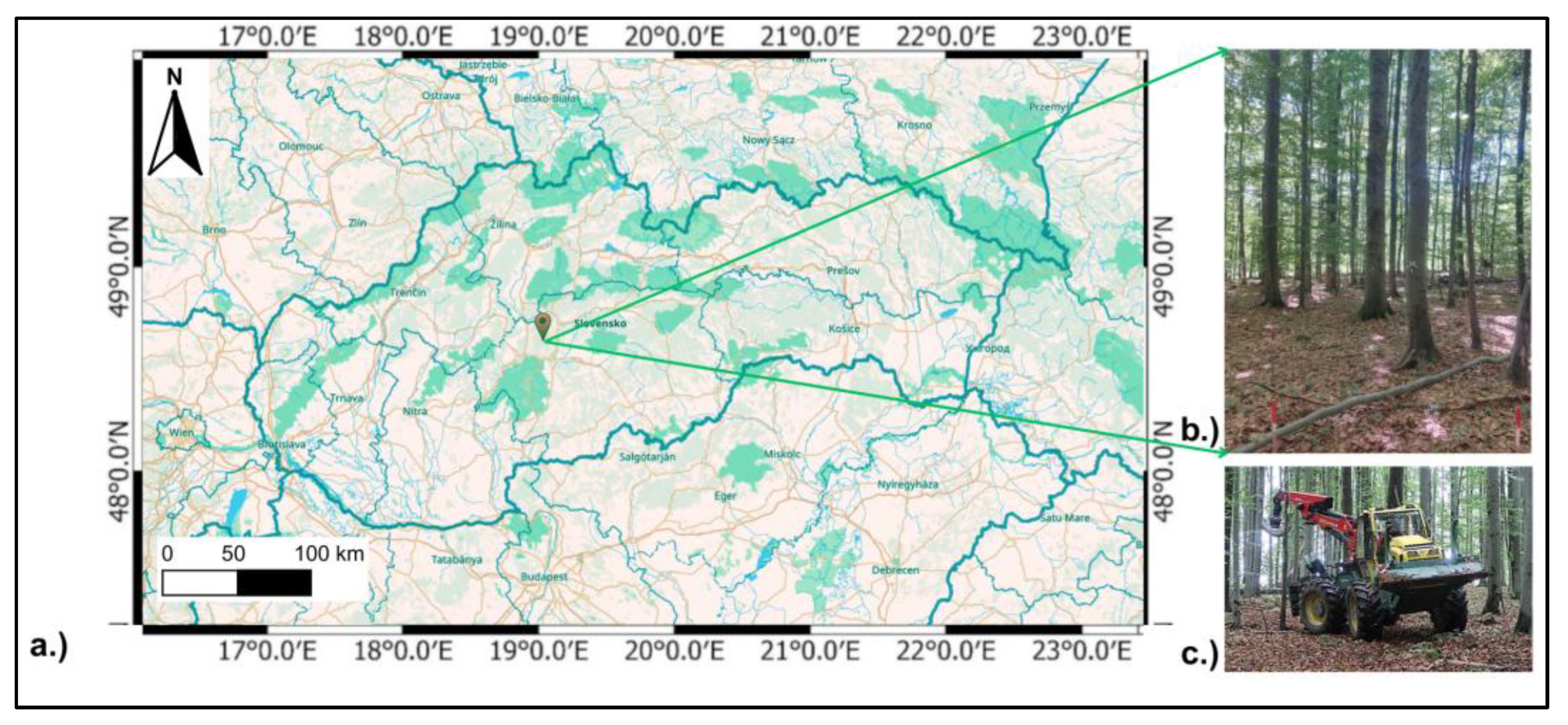

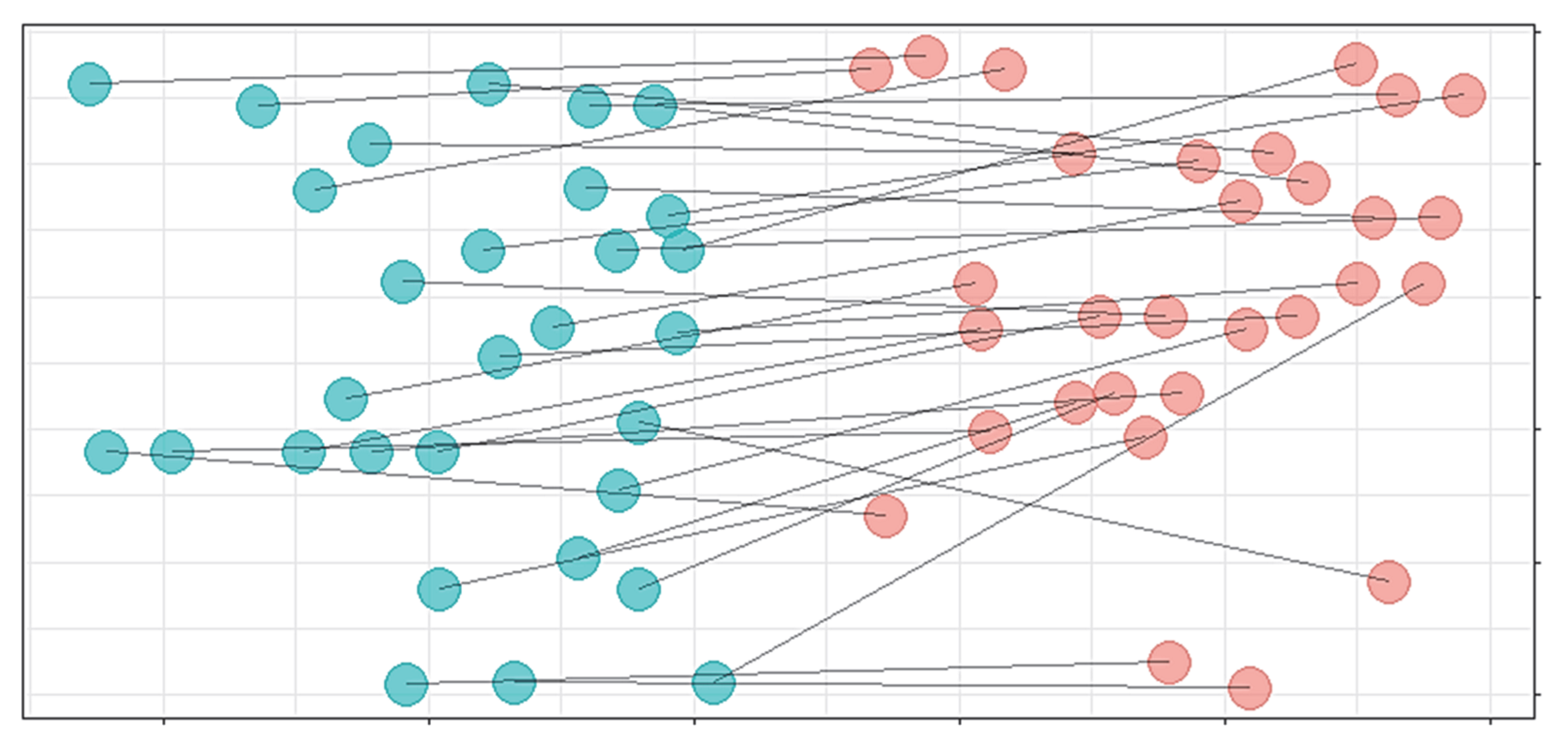
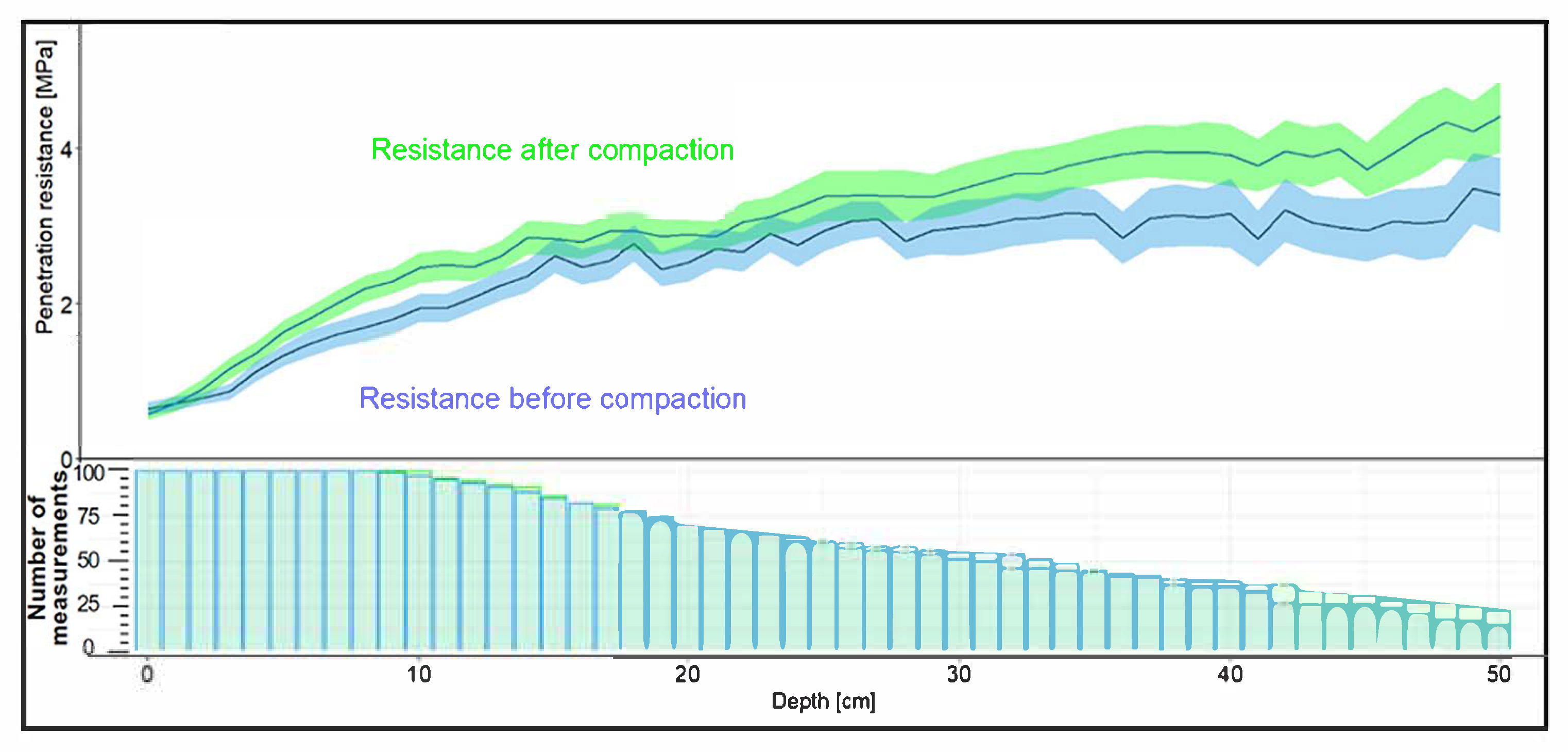
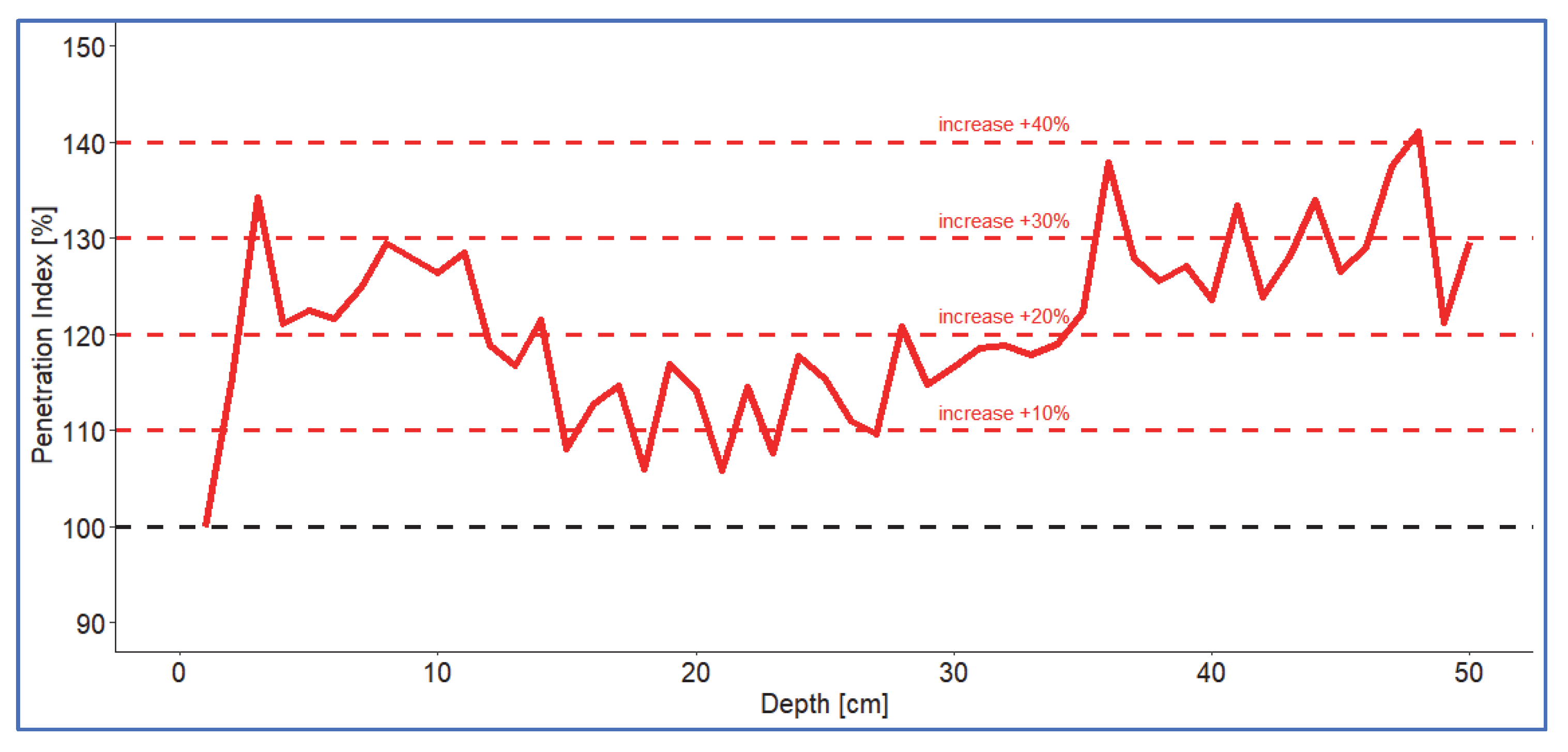
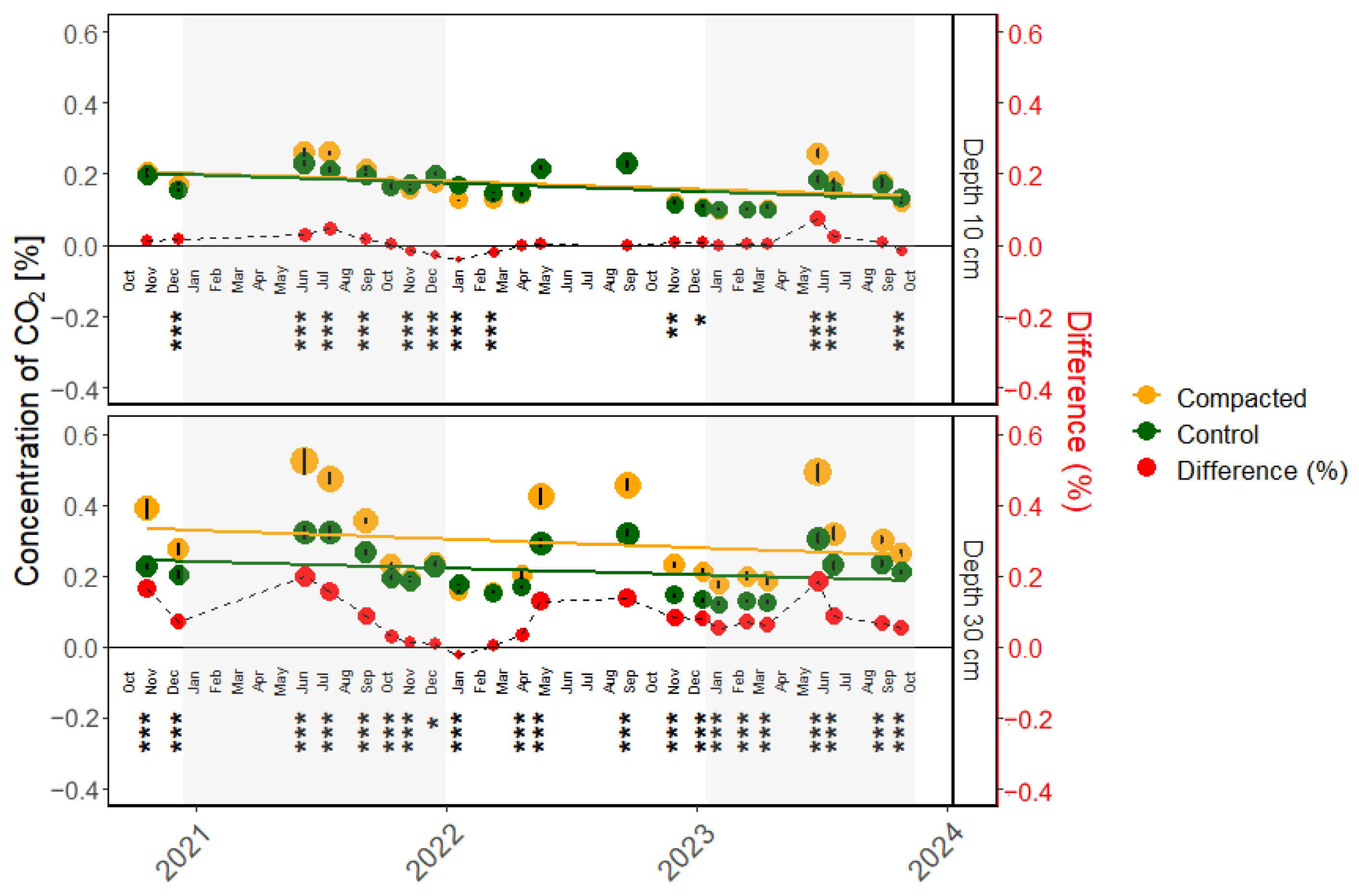
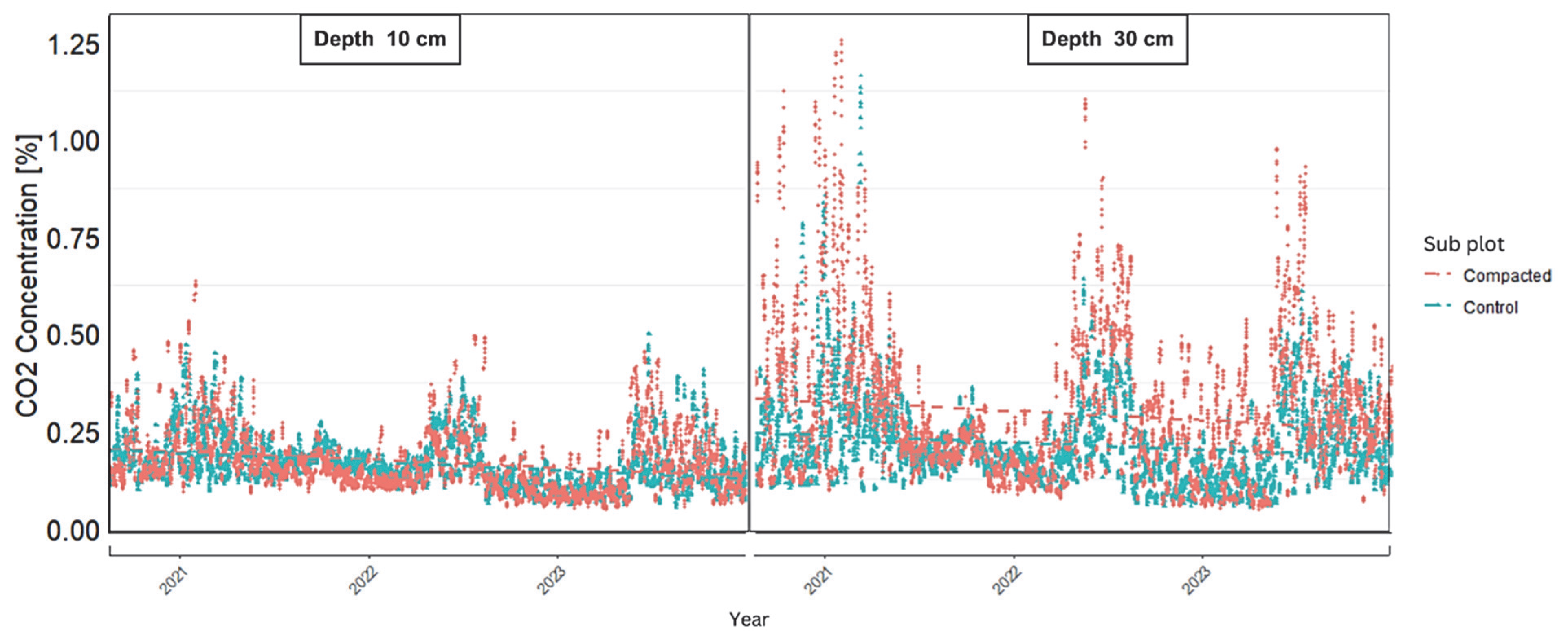
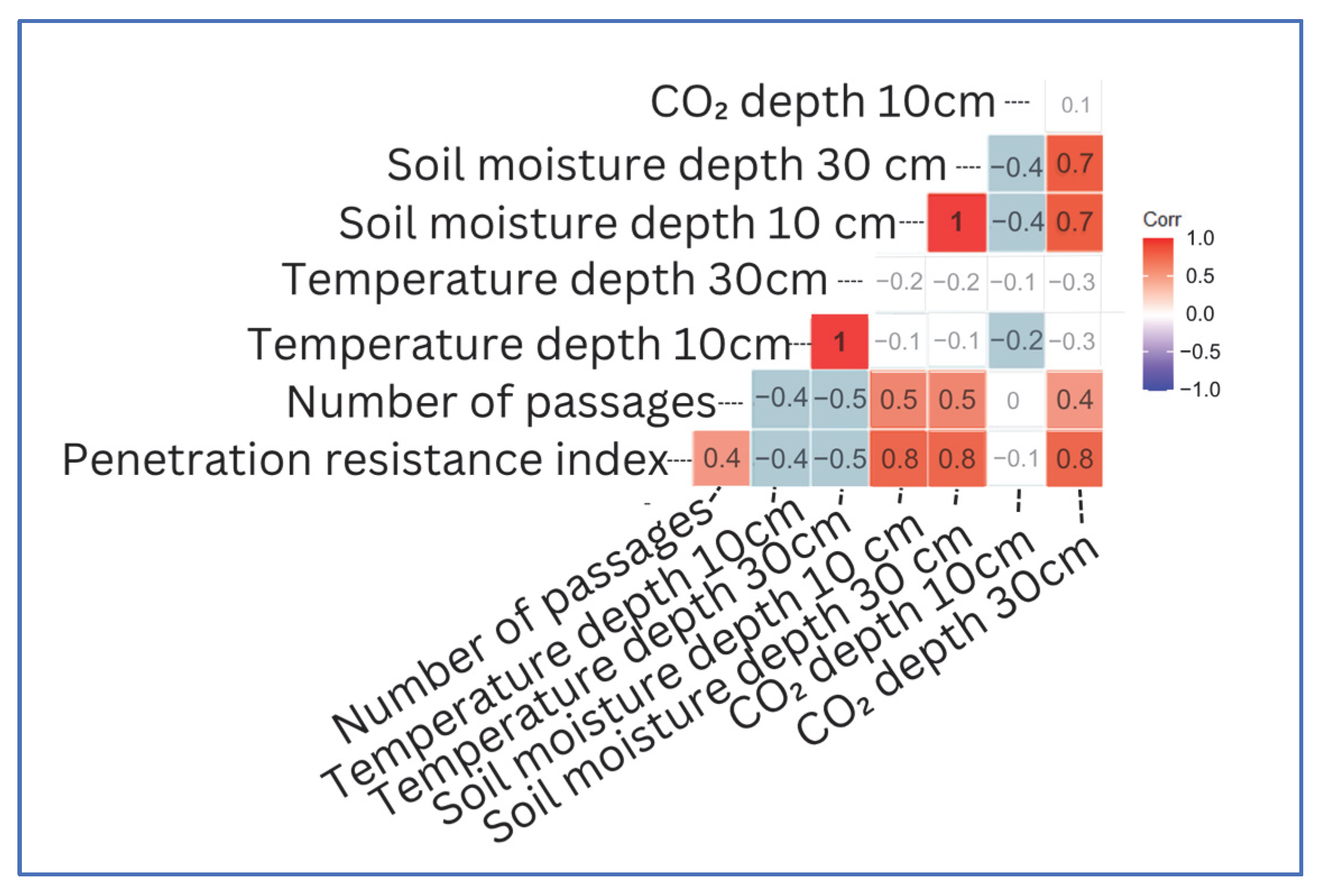
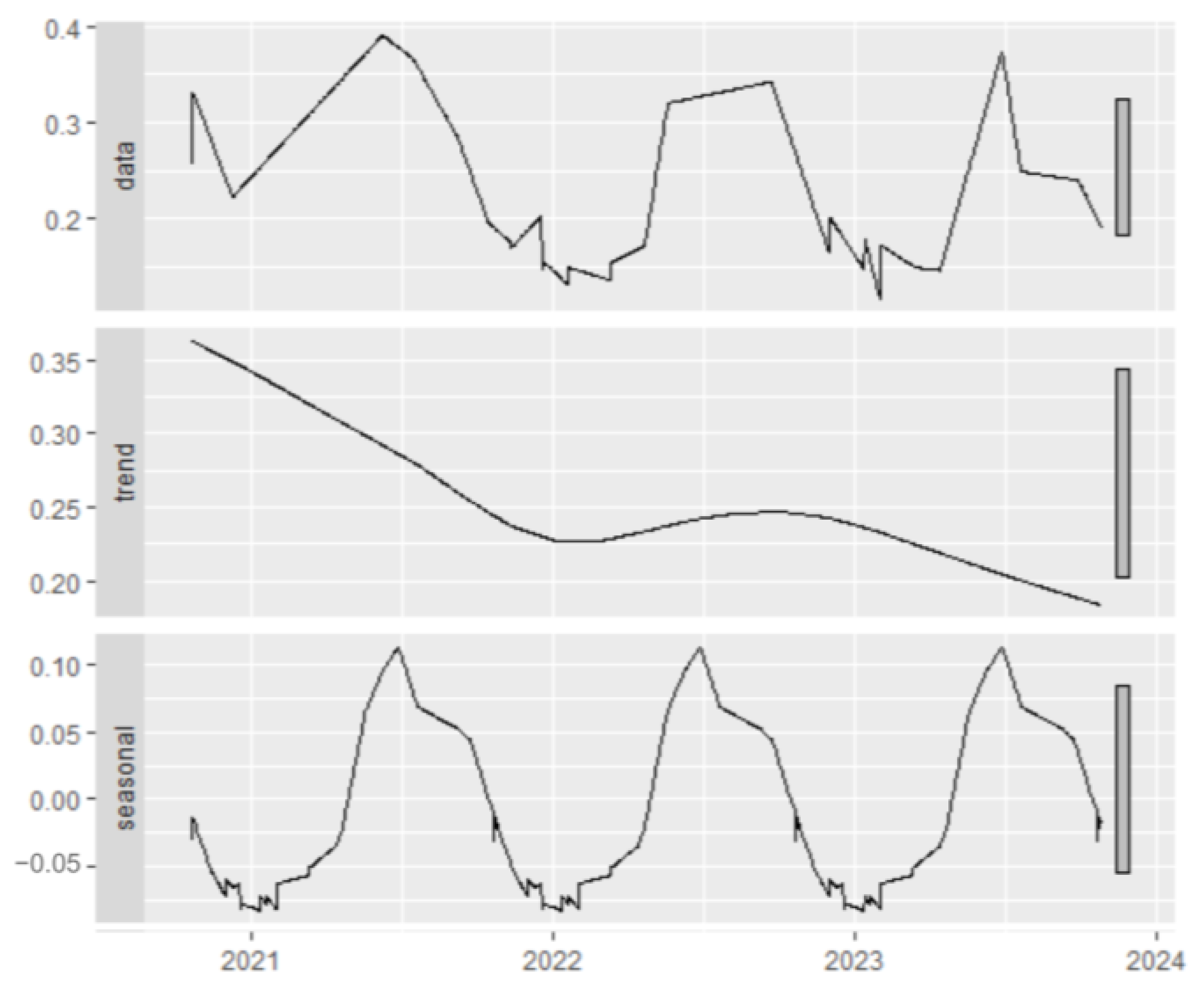
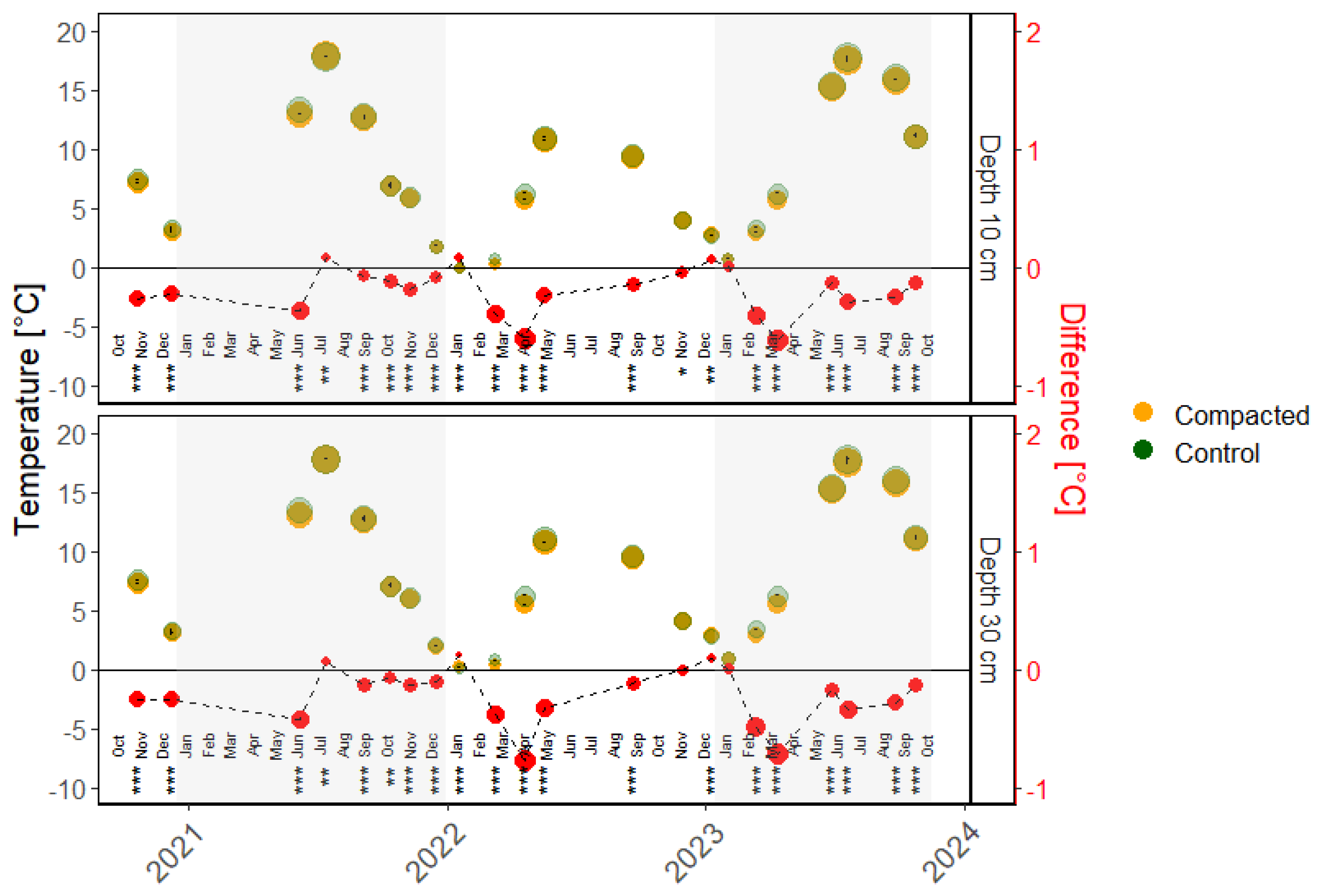
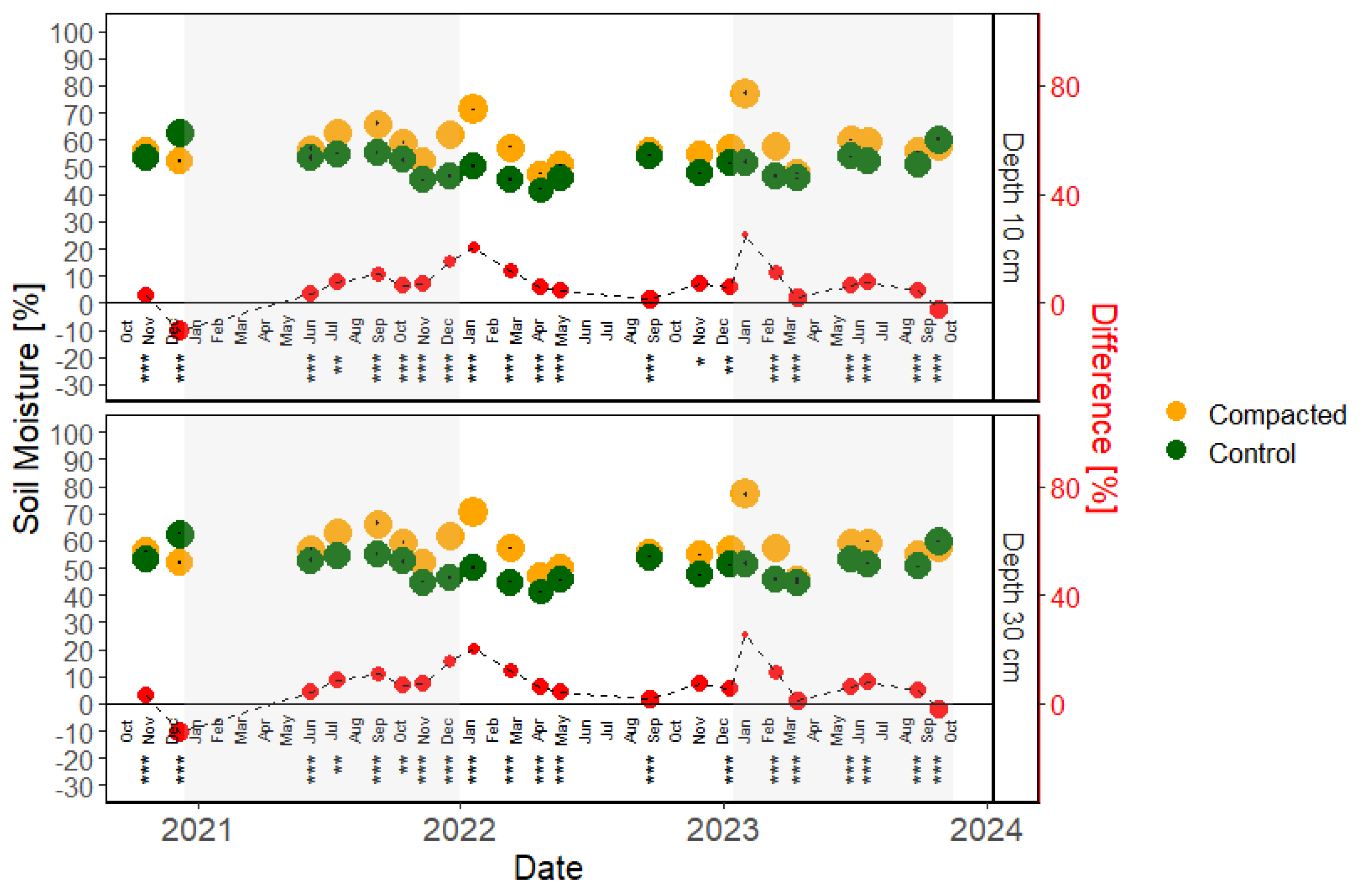
| Stand Characteristic | |
| Stand No. | 554 |
| Age (years): | 95 |
| Area of stand (ha) | 5.82 |
| Stocking degree | 0.87 |
| Slope (%) | 20 |
| Aspect | West |
| Management system | Shelterwood |
| Altitude (m a. s. l.) | 710 |
| Tree species composition (%) | Fagus sylvatica L. (73); Abies alba Mill. (24), Picea abies (L.) H. Karst. (3) |
| Skidding distance (m) | 50 |
| Soil type | Cambisol |
| Soil texture | Silt Clay |
| Site Characteristic | |
| Tree species composition (%) | Fagus sylvatica L. (95); Abies alba Mill. (5) |
| Slope | 0%–5% |
| Loam content (<0.002 mm) (%) | 4.5 |
| Silt content (0.002–0.063 mm) (%) | 69.13 |
| Sand content (0.063–2 mm) (%) | 26.82 |
| Engine | Hydraulic Manipulator | Machine Width (cm) | Front/Rear Tires (inch) | Tires Type | Tire (Front/Rear) Inflation Pressure (MPa) | Front Axle Weight (kg) | Rear Axle Weight (kg) | Total Mass (kg) |
|---|---|---|---|---|---|---|---|---|
| JCB 448 TA1(JCB Power Systems, Derby, UK) | Epsilon M90 R72 | 250 | 540/70–30 | Nokian Forest King | 2.0/2.4 | 4230 | 6370 | 10,600 |
| Mean ± CI95% | |||||||||
| Parameter | p-Value | ||||||||
| Soil Depth 0–10 cm | Soil Depth 10–20 cm | Soil Depth 20–30 cm | |||||||
| Control | Compacted | Control | Compacted | Control | Compacted | ||||
| Sub-Plot | Sub-Plot | Sub-Plot | Sub-Plot | Sub-Plot | Sub-Plot | ||||
| Bulk density [kg·m−3] | 714.8 ± 47.88 | 800.85 ± 54.07 | 1065.86 ± 38.93 | 1078.58 ± 48.2 | 1197.57 ± 36.51 | 1204.64 ± 42.16 | |||
| 0.177 | 0.680 | 0.800 | |||||||
| Fine solid soil fraction < 0.025 mm [%] | 68 ± 3.2 | 63 ± 2.96 | 71.24 ± 3.2 | 65.09 ± 3.01 | 68.4 ± 4.34 | 66.94 ± 3.36 | |||
| 0.703 | 0.416 | 0.100 | |||||||
| Fine solid soil fraction ≥ 0.025 mm ≤ 2 mm [%] | 13.27 ± 1.72 | 15.13 ± 1.47 | 11.42 ± 1.25 | 12.91 ± 1.06 | 11.36 ± 1.64 | 12.24 ± 1.02 | |||
| 0.730 | 0.912 | 0.999 | |||||||
| Fine solid soil fraction > 2 mm ≤ 4 mm [%] | 3.46 ± 0.5 | 3.29 ± 0.44 | 2.7 ± 0.38 | 2.47 ± 0.34 | 2.75 ± 0.63 | 2.48 ± 0.41 | |||
| 0.999 | 0.999 | 0.999 | |||||||
| Fine solid soil fraction > 4 mm [%] | 11.16 ± 2.16 | 14.45 ± 3.33 | 13.95 ± 2.97 | 18.76 ± 3.21 | 17.14 ± 3.91 | 17.98 ± 3.64 | |||
| 0.964 | 0.731 | 0.999 | |||||||
| Soil Depth 30–40 cm | Soil Depth 40–50 cm | ||||||||
| Control | Compacted | Control | Compacted | ||||||
| Sub-plot | Sub-plot | Sub-plot | Sub-plot | ||||||
| Bulk density [kg·m−3] | 1239.53 ± 46.29 | 1248.54 ± 43.4 | 1242.05 ± 37.41 | 1214.4 ± 59.72 | |||||
| 0.776 | 0.432 | ||||||||
| Fine solid soil fraction < 0.025 mm [%] | 67.84 ± 5.15 | 61.66 ± 4.74 | 64.73 ± 4.84 | 61.61 ± 4.22 | |||||
| 0.449 | 0.985 | ||||||||
| Fine solid soil fraction ≥ 0.025 mm ≤ 2 mm [%] | 11.11 ± 1.61 | 13.87 ± 1.65 | 14.17 ± 1.96 | 15.93 ± 1.45 | |||||
| 0.222 | 0.842 | ||||||||
| Fine solid soil fraction > 2 mm ≤ 4 mm [%] | 2.4 ± 0.43 | 2.88 ± 0.56 | 3.31 ± 0.73 | 3.47 ± 0.66 | |||||
| 0.946 | 0.999 | ||||||||
| Fine solid soil fraction > 4 mm [%] | 17.97 ± 4.94 | 21.26 ± 5.1 | 17.39 ± 4.46 | 18.52 ± 4.09 | |||||
| 0.971 | 0.999 | ||||||||
Disclaimer/Publisher’s Note: The statements, opinions and data contained in all publications are solely those of the individual author(s) and contributor(s) and not of MDPI and/or the editor(s). MDPI and/or the editor(s) disclaim responsibility for any injury to people or property resulting from any ideas, methods, instructions or products referred to in the content. |
© 2025 by the authors. Licensee MDPI, Basel, Switzerland. This article is an open access article distributed under the terms and conditions of the Creative Commons Attribution (CC BY) license (https://creativecommons.org/licenses/by/4.0/).
Share and Cite
Tomčík, D.; Merganič, J.; Juško, V.; Ferenčík, M.; Allman, M.; Dudáková, Z.; Vlčková, M.; Merganičová, K.; Výbošťok, J. Assessing the Impact of Forest Machinery Passage on Soil CO2 Concentration. Forests 2025, 16, 1025. https://doi.org/10.3390/f16061025
Tomčík D, Merganič J, Juško V, Ferenčík M, Allman M, Dudáková Z, Vlčková M, Merganičová K, Výbošťok J. Assessing the Impact of Forest Machinery Passage on Soil CO2 Concentration. Forests. 2025; 16(6):1025. https://doi.org/10.3390/f16061025
Chicago/Turabian StyleTomčík, Daniel, Ján Merganič, Vladimír Juško, Michal Ferenčík, Michal Allman, Zuzana Dudáková, Mária Vlčková, Katarína Merganičová, and Jozef Výbošťok. 2025. "Assessing the Impact of Forest Machinery Passage on Soil CO2 Concentration" Forests 16, no. 6: 1025. https://doi.org/10.3390/f16061025
APA StyleTomčík, D., Merganič, J., Juško, V., Ferenčík, M., Allman, M., Dudáková, Z., Vlčková, M., Merganičová, K., & Výbošťok, J. (2025). Assessing the Impact of Forest Machinery Passage on Soil CO2 Concentration. Forests, 16(6), 1025. https://doi.org/10.3390/f16061025






